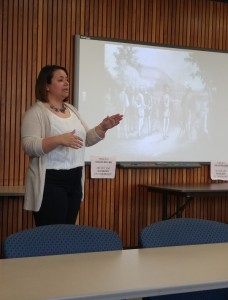Historical figures showcased in historical comparison
Comparing two of the more famous western European explorers from different time periods required some innovative thinking by SIUE graduate student Samantha Thompson.

Historical Studies graduate student Samantha Thompson speaks during her presentation at Peck Hall April 8. (Photo by Joseph Lacdan)
Thompson compared the two explorers during her Brown Bag series presentation titled “Motivations for Explorers: Shifting Viewpoints from the Middle Ages to the Early Modern Period,” April 8 at Peck Hall. Thompson chose to compare the two explorers because of the similarities of their expeditions and their descriptive styles of documenting the new lands they explored, Marco Polo and Jacques Cartier.
“They were both traveling from western Europe to an area that had not been previously discovered or explored by western Europeans,” Thompson said. “And because they’re adopting their narrative with very similar language [and] the way they are using comparisons, they help readers better understand what they’re saying. And because they both rose to fame posthumously later and were sort of drawn upon as the fathers or great people for their nation. I picked them because of their proximity [in history]. Cartier was so close to 1492 and the changes that happened at that moment. I picked Marco Polo because he best represents the Middle Ages before it’s been tainted with this New World idea.”
Polo, an Italian largerly known for his exploration of the Orient, is known for his detailed account of China.
The presentation was part of Thompson’s master’s thesis that was divided into three parts: a research paper on the comparison of the two figures, a comparison of maps documenting their voyages and a virtual interactive display where viewers can challenge Thompson’s conclusions and arguments.
Polo’s unique descriptive style included attempting to describe the terrain, geography, animal life and plant life and paint a picture in his reader’s minds. Thompson said Polo’s writing style is descriptive and informational.
“Polo’s description of his journey takes a picture for his audiences so that they’ll be able to see what he sees and what he wants them to see,” Thompson said.
Cartier, a Frenchman, was born seven months before Christopher Columbus’ voyage to the New World. Cartier was known for his exploration of North and South America, most notably the St. Francis river area in Canada and Brazil. Carter, like Polo, annotated his travels in French. But unlike Polo. Cartier documented distances, direction taken, and terrain and geography, Thompson said. Thompson used standardized distance and highlighted landmarks.
Thompson said dividing her thesis into three parts and using digital technology can better illustrate this type of historical comparison than a standard research paper could. Last summer Thompson completed an internship program through the SIUE museum studies program and Brown University called Second Life, which allows users to virtually recreate real places. Thompson digitally generated a virtual museum exhibit on 18th century Naples. Thompson hopes to work as a curator and educator in a museum.
“I think this a good way to make me more attractive on the job market that I have these digital skills that I can use,” Thompson said. “And also you need to open yourself up more to these digital areas and make yourself more appealing. I think that by using the digital website then I can show my readers exactly what I’m talking about. You can see the maps that I’m discussing and you can scroll to certain portions and explore them for yourself.”
Filed Under: Historical Studies • Uncategorized












